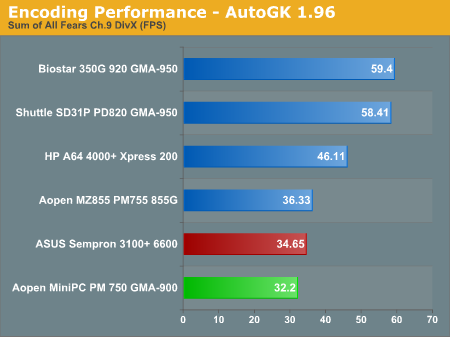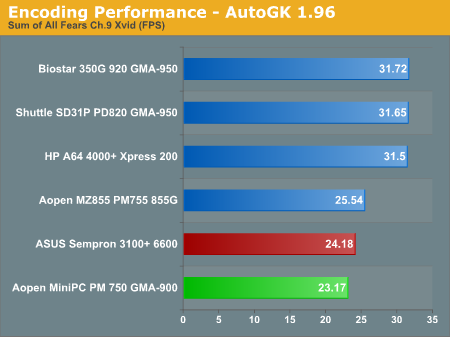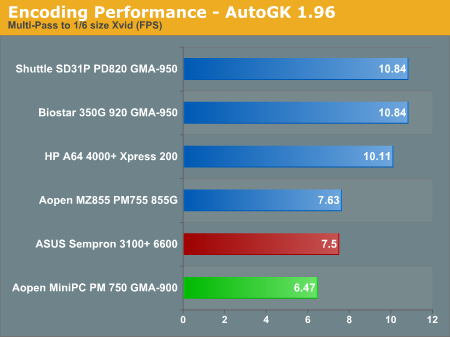Updated: AOpen MiniPC – Imitation is the Sincerest Form of Flattery
by Jarred Walton on March 3, 2006 12:05 AM EST- Posted in
- Systems
Encoding and Multimedia Benchmarks
Using AutoGK, we tested the multimedia encoding capabilities of the systems. For HTPC use, we tested the playback of several different video files as well and checked CPU use. For video playback, we used DVI as well as component output running 720p resolutions. We also tested performance connected to a Dell 2405FPW running at the native 1920x1200 resolution of the display, as video scaling can increase the load on the system for video content. The Pentium 4 506 chip had some issues during testing, so unfortunately, we didn't get AutoGK results with it.
DivX and Xvid encoding are good enough for casual use, but clearly, the Pentium M chip is not as fast as other platforms. Even the lowly Sempron 3100+ outpaces the Pentium M 740, though the margin is relatively close. Running a Core Duo processor would help quite a bit, but even that wouldn't catch up with Pentium D or Athlon X2 performance. For multimedia creation, the MiniPC is probably too slow for serious work. However, if you just want to encode the occasional video clip, letting the system process the file overnight will get the job done before you wake up in the morning. WMV9HD encoding is a different matter, but that's slow even on the fastest dual core systems.
Video Decoding
If you have a second PC doing the encoding work, the MiniPC works quite well as an HTPC. For video playback, there won't be any graphs, but I instead focused on the overall experience. Lower demand playback like MPEG-2 isn't even remotely a problem, so let's move on to the more demanding tasks.
Playing back 720p and 1080i content - even with scaling the video to fill the screen - worked without a hitch, with the CPU running a maximum of 50-80% load. (We'll talk a bit more about 1080i content later.) Every now and then, you might see a slight skip, most likely caused by another application using the hard disk, but otherwise, HDTV content worked fine. DivX and Xvid playback presented no difficulties either, with CPU load for both under 25% at typical (720x480) resolutions. DivXHD used more CPU time for the higher resolution, but playback still only used about 50% of the CPU power.
The other systems were all equal to the MiniPC or substantially better, but the bottom line is that for the currently most common video formats, all of the tested systems handled MPEG-2/HD/DivX/Xvid video playback with enough CPU power left in reserve that stutters shouldn't be a problem. Multitasking might present problems on the slower systems, of course, so we wouldn't recommend trying dual display output on the MiniPC with one display showing an HDTV stream, if you're trying to get work done, but few people really do that in our experience.
WMV9HD is a different story, but we've come to expect that from our most brutal video playback tests. 720p was okay, though it sometimes struggled (hitting upwards of 80% CPU usage); basically, it ran about as well as a 1080i HD transport stream. 1080p on the other hand was essentially unwatchable. Dual cores and even GPU acceleration are pretty much required to get completely smooth WMV9HD support for 1080p content; even a fast Athlon X2 or Pentium D will struggle with 1080p WMV9HD decoding, unless the GPU offloads some of the work. As nice as WMV9HD looks, it's difficult to justify the performance requirements at this time. DivXHD files encode and decode with much less CPU power, and file sizes are pretty comparable. As long as you stick to the other less CPU intensive codecs, the MiniPC will work fine.
Using AutoGK, we tested the multimedia encoding capabilities of the systems. For HTPC use, we tested the playback of several different video files as well and checked CPU use. For video playback, we used DVI as well as component output running 720p resolutions. We also tested performance connected to a Dell 2405FPW running at the native 1920x1200 resolution of the display, as video scaling can increase the load on the system for video content. The Pentium 4 506 chip had some issues during testing, so unfortunately, we didn't get AutoGK results with it.




DivX and Xvid encoding are good enough for casual use, but clearly, the Pentium M chip is not as fast as other platforms. Even the lowly Sempron 3100+ outpaces the Pentium M 740, though the margin is relatively close. Running a Core Duo processor would help quite a bit, but even that wouldn't catch up with Pentium D or Athlon X2 performance. For multimedia creation, the MiniPC is probably too slow for serious work. However, if you just want to encode the occasional video clip, letting the system process the file overnight will get the job done before you wake up in the morning. WMV9HD encoding is a different matter, but that's slow even on the fastest dual core systems.
Video Decoding
If you have a second PC doing the encoding work, the MiniPC works quite well as an HTPC. For video playback, there won't be any graphs, but I instead focused on the overall experience. Lower demand playback like MPEG-2 isn't even remotely a problem, so let's move on to the more demanding tasks.
Playing back 720p and 1080i content - even with scaling the video to fill the screen - worked without a hitch, with the CPU running a maximum of 50-80% load. (We'll talk a bit more about 1080i content later.) Every now and then, you might see a slight skip, most likely caused by another application using the hard disk, but otherwise, HDTV content worked fine. DivX and Xvid playback presented no difficulties either, with CPU load for both under 25% at typical (720x480) resolutions. DivXHD used more CPU time for the higher resolution, but playback still only used about 50% of the CPU power.
The other systems were all equal to the MiniPC or substantially better, but the bottom line is that for the currently most common video formats, all of the tested systems handled MPEG-2/HD/DivX/Xvid video playback with enough CPU power left in reserve that stutters shouldn't be a problem. Multitasking might present problems on the slower systems, of course, so we wouldn't recommend trying dual display output on the MiniPC with one display showing an HDTV stream, if you're trying to get work done, but few people really do that in our experience.
WMV9HD is a different story, but we've come to expect that from our most brutal video playback tests. 720p was okay, though it sometimes struggled (hitting upwards of 80% CPU usage); basically, it ran about as well as a 1080i HD transport stream. 1080p on the other hand was essentially unwatchable. Dual cores and even GPU acceleration are pretty much required to get completely smooth WMV9HD support for 1080p content; even a fast Athlon X2 or Pentium D will struggle with 1080p WMV9HD decoding, unless the GPU offloads some of the work. As nice as WMV9HD looks, it's difficult to justify the performance requirements at this time. DivXHD files encode and decode with much less CPU power, and file sizes are pretty comparable. As long as you stick to the other less CPU intensive codecs, the MiniPC will work fine.










54 Comments
View All Comments
JarredWalton - Friday, March 3, 2006 - link
"...*original* Mac Mini...."The Core Duo version was officially launched this past week.
mlittl3 - Friday, March 3, 2006 - link
Jarred,Since the article was posted today, I don't think anyone is going to care about the original Mac Mini. The computer industry moves and it moves fast. If Aopen's mini is better than what Apple put out in the past, then Apple has solved that problem with the new Mac Mini. That is the important issue today.
JarredWalton - Friday, March 3, 2006 - link
I Aopen had sent this to me in the past week, I wouldn't have bothered with the review. I've been putting this unit through it's paces for a lot more than a week, so the launch of the new Mac Mini is a non-factor. I mentioned it, I suggested it's a better choice right now (at least, I feel I did), and I really wouldn't recommend this model to anyone unless it were to sell for $650 or less. (Core Solo is for all intents and purposes equal to Dothan, so if it matches the Core Solo priced Mac Mini it would be fine.)JarredWalton - Friday, March 3, 2006 - link
First word: "I" should be "If..."Update #2: I'm betting not many people bothered reading the whole article, so they missed the comments on page 10 implying that the new Mac Minis are clearly faster. ("...with the recent launch of the Intel-based Mac Minis, that advantage is going to be short-lived.") I've updated the conclusion to make more specific mention of the Core Duo Mac Mini priced at $800.
Sunbird - Friday, March 3, 2006 - link
Looks like they followed my http://www.dailytech.com/article.aspx?newsid=937">advice on the styling (I can dream cant I?) and its not silver and blue.I like it.
Sunbird - Friday, March 3, 2006 - link
A question though:Is all the hardware OSx86 compatible?
Then you could enjoy the best of both worlds on one little box...
plinden - Friday, March 3, 2006 - link
I'm afraid I'm going to have to sound like an Apple fanboi now, but AOpen are still playing catchup with Apple:So to compare the specs:
Processor: Intel socket 479 (Celeron M to Pentium M 740) - Intel Core Solo/Duo
RAM: 1 X DDR2 SO-DIMM (Maximum 1GB of RAM) - 2 GB RAM Max
Hard Drive: 2.5" PATA Notebook HDD - Same HD
Graphics: 915GM (Intel GMA900) - Intel GMA950
Optical Drive: Slim CD/DVD slot load - same or similar, i.e. combo or superdrive
Expansion Slots: 1 X Mini-PCI (for WiFi) - no expansion slot but WIFI and bluetooth included by default
Audio: Realtek ALC655 AC'97 2CH (Speaker/Headphones + Microphone) - S/PDIF output
Power Suply: 65W (19V, 3.5A) External Adapter - 85W power supply
Internal connections from motherboard to HDD and ODD
Front Ports: None. Power Button, HDD Activity LED, ODD Eject Button - same
Rear Ports: 2 X USB2.0 - 4xUSB2.0
2 X 3.5mm Audio (speakers and microphone)
LAN (GbE) - same
1 X DVI-D and 1 X TV-Out (S-VIDEO, Composite, Component) - 1xDVI, no TV out
1 X Optional WiFi Antenna wireless G included
All for $599 - $799 (for 512MB RAM).
Despite the moaning over on Mac forums, this is still a much better deal than the MiniPC.
mlittl3 - Friday, March 3, 2006 - link
The hard drive in the Mac Mini is SATA not PATA.JarredWalton - Friday, March 3, 2006 - link
Which is basically what I say in the conclusion. This MP915 has been done for about three months now, and available on the market for just over a month (and a bit longer in Europe/Asia). MP945 will go up against the new Mac Mini, but the real question is whether or not it can come close to matching Apple's price. I'd like $850 with Core Duo 1.86 GHz (or higher), XP Home, 60+ GB HDD, DVD+RW, and 1GB RAM standard. I've said as much to AOpen, so we'll see if they can do that or not.JarredWalton - Friday, March 3, 2006 - link
Ack!Bold off Let's see if that works.... :p